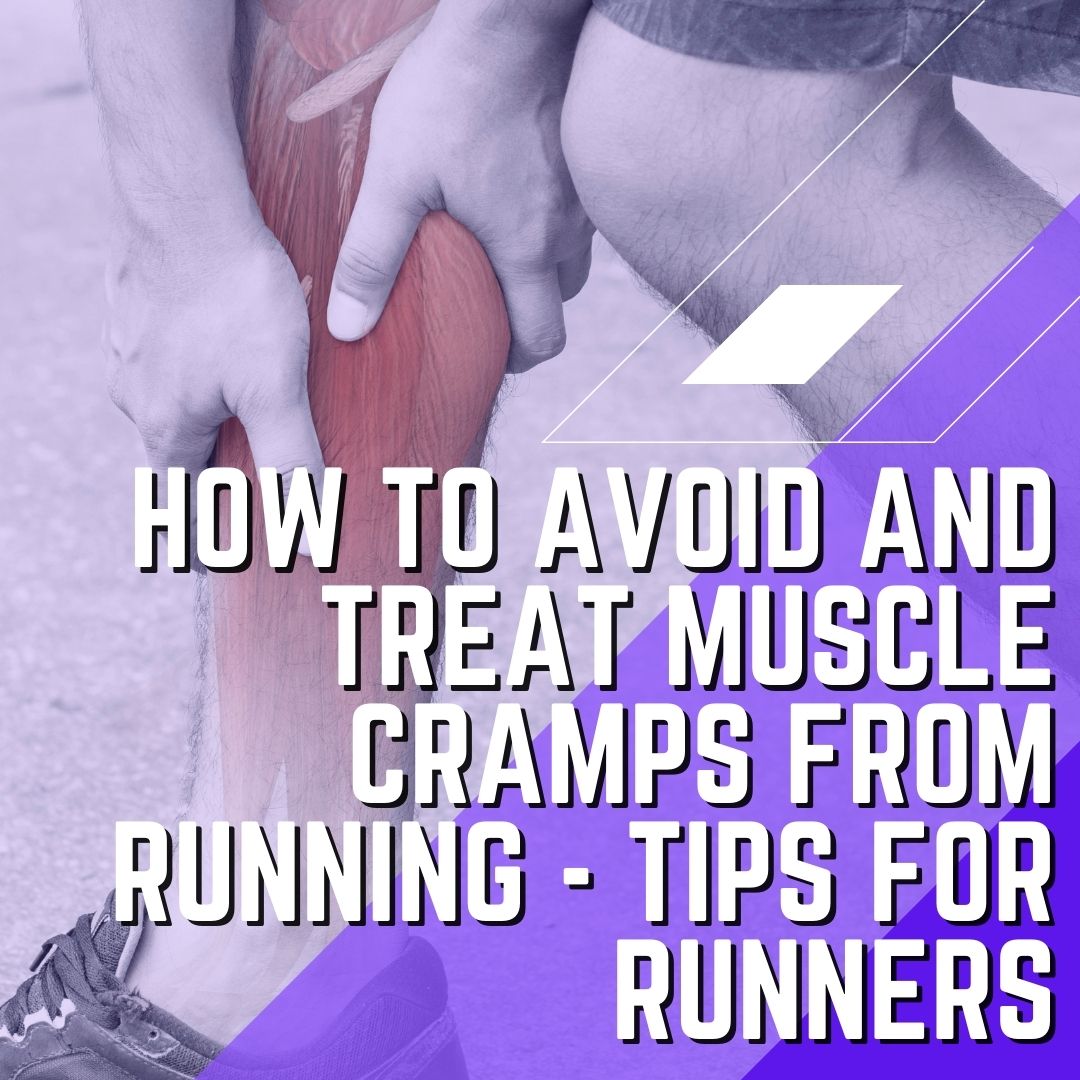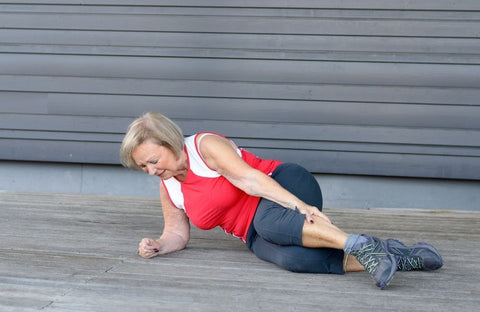
How to Avoid and Treat Muscle Cramps From Running - Tips for Runners
Share

Do you get leg muscle cramps from running?
If you are a runner, most likely your muscles have cramped up at some point.
Leg muscle cramps can be painful but they don't need to slow down your training. Here is how to avoid leg muscle cramping and treat them if you do get one!
First of all, what causes these annoying little pains? Cramps happen!
We all know that running is good for us it improves cardiovascular health, helps control weight, and reduces stress levels. But it also has some downsides like increased risk of injury or illness due to overtraining or inadequate recovery time between workouts. One of these downsides is muscle cramping which can cause a lot of pain and discomfort while running. The good news is that there are ways to prevent this from happening again! Here are some tips on how to treat leg muscle cramps during your run so you can continue enjoying the benefits of exercise without any more pain!
What are Muscle Cramps and How do they Affect Runners
Cramps are pains in your muscles that can make it hard for you to continue running. They cause a lot of pain and discomfort which usually stop when the muscle is stretched or massaged.
Muscle cramping occurs because these contractions become stronger than their opposing relaxation forces in other words, they get "stuck" in the contracted position.
Most cramps can be prevented by maintaining a proper balance of electrolytes, water, and carbohydrates in the body a routine that is easily achieved if you eat healthy foods regularly. Of course, this isn't always possible when we are running long distances or during intense workouts where carb gels may provide some added nutritional support for your muscles.
Types of Muscle Cramps
There are several types of muscle cramps that runners experience.

The most common is exertional or exercise-related muscle cramping which occurs when the muscles in your legs get fatigued and spasm, usually during a strenuous activity like running.

Muscle fatigue can cause a breakdown in communication between nerves and muscles resulting in involuntary contractions. This type of cramping is the most common in endurance athletes, especially runners.
Other types of muscle cramping that affect runners are called "neuromuscular" or "non-exertional" and these do not result from fatigue but rather a disturbance in nerve impulses to muscles which can cause pain with no actual spasms seen by an examiner.

Neuromuscular cramps are the least studied of the two types, but they can happen in runners from time to time. A common example is a "charley horse," which occurs when you're sitting still and all of a sudden feel a painful muscle spasm that typically lasts for 30 seconds or less. These non-exertional cramps can also occur in the foot or leg muscles.

"Reflex" muscle cramping is another type that involves an abnormal activation of a nerve, which causes your muscles to contract without any activity on your part. This rare form is sometimes caused by low levels of potassium, calcium, and/or magnesium when you are running for long periods of time.
Treatment Options for Muscle Cramps
Some examples of different methods runners can use to treat muscle cramps include:
-
Massage the affected area if it is a neuromuscular or "reflex" type cramp. You can also try adjusting your running technique by changing up how you strike the ground with each step, as well as loosening your shoes and clothing around the cramped area.
-
If the muscle is still in spasm, stretch it by grabbing your foot and pulling until you feel a gentle release of tension. Also, try rotating or bending the affected limb to help relieve some of the pain just be sure that if there's any numbness or tingling then stop immediately! It means that the muscle is still spasming and you could be doing more harm than good.
-
Take a salt tablet or use an electrolyte powder to help replace the minerals that are lost during sweat. You can also try eating bananas, raisins, pretzels, or bagel chips since they contain potassium which helps prevent cramping and drinking lots of water to stay hydrated.
- Stay healthy by practicing good nutrition, staying active, and keeping up with your training program so that you are ready for any physical challenge ahead!
Prevention Steps to Avoid Muscle Cramps in the Future

-
A great method to help avoid muscle cramps is staying healthy, active, and hydrated so you are ready for any physical challenge ahead. This means practicing good nutrition by eating a balanced diet of proteins, carbohydrates, vegetables, and fruits as well as being physically active on most days each week with training programs that work the muscles in your legs and feet.
- Another good tip is to incorporate strength training into your weekly routine because it helps prevent injuries and increases balance, which can help keep you from falling or tripping due to a loss of stability which could lead to injury like a pulled muscle. Strength training also improves blood flow and circulation throughout the body, which means more oxygen delivered to your muscles which can help you perform better and reduce the risk of cramping.
-
In addition, try to get at least eight hours of sleep each night because it helps regulate many important bodily functions that are essential for health and recovery from exercise. When you're trying to improve performance or prevent injury during a training program, lack of adequate sleep can interfere with both.
- Finally, keep your muscles loose by doing some light stretches before you run or strength train and drink plenty of water throughout the day! Being hydrated will help prevent cramping during exercise so be sure to sip on fluids every 15–20 minutes when exercising for over an hour.
Exercises that can help prevent or treat muscle cramps
Try these exercises that can help prevent or treat muscle cramps:

Toe Taps:
Lift your toes and tap the floor before each step while walking in place for about two minutes straight; repeat one to three times per day.

Deep Squatting with Chest Expansion:
Stand tall, feet shoulder-width apart and place your elbows on top of your knees you should be able to feel the stretch in your chest as you take deep breaths for about fifteen seconds before releasing; repeat three times with thirty-second breaks between each repetition.

Standing Calf Raises:
This is a great exercise that can help prevent or treat muscle cramps in runners. To do the standing calf raise, stand on your tiptoes before slowly lowering yourself back down to starting position with control for about thirty seconds—repeat three times.

Lying Hip Extension:
This is a great exercise that can help prevent or treat muscle cramps in runners because it targets the hamstrings which are often weak in runners. For the lying hip extension, lie on your back with both of your feet flat on the ground and slightly bend your knees—lift one leg about twenty inches off of the ground by flexing at the hips so that you feel a stretch in your hamstring before slowly lowering it to starting position; repeat three times for each leg.

Scissor Kicks:
This is another great exercise that can help prevent or treat muscle cramps in runners. To do scissor kicks, lie on your back with both of your feet flat on the ground and slightly bend your knees—lift one leg about twenty inches off of the ground by flexing at the hips so that you feel a stretch in your hamstring before slowly lowering it to starting position; repeat three times for each leg.

Hamstring Stretch:
This is another great exercise that can help prevent or treat muscle cramps in runners because it targets a group of muscles called the hamstrings. To do the hamstring stretch, lie on your back with both of your feet flat on the ground—lift one leg so that it is perpendicular to the floor while keeping your other foot firmly planted; use your hands to pull your raised leg toward you until you feel a comfortable stretch in the hamstrings before slowly lowering it down again; repeat three times for each leg.

Side-Lying Leg Raise:
This is one of the best exercises that can help prevent or treat muscle cramps in runners because it targets the glutes which are often weak in runners—this exercise should be done on both sides before switching to another side. For the side-lying leg raise, lie sideways with your head on a pillow and both of your legs bent at the knee—raise your top leg about twenty inches off of the ground before slowly lowering it back down with control; repeat three times for each leg.

Bridge:
This is one of the best exercises that can help prevent or treat muscle cramps in runners because it stretches out all muscles from the neck to the feet—this exercise should be done on both sides before switching to another side. To do a bridge, lie down with your knees bent and place your arms at your sides for support; push off of the ground using only your heels until you are in a straight line from head to toe while squeezing your glutes throughout this movement; hold this bridge for a few seconds before lowering back down with control.
Additional tips for running and prevention of muscle cramp pain
Try to eat foods that are high in potassium, like bananas and oranges and stay away from sugary soft drinks which can be dehydrating! If you're exercising for more than two hours then consider taking a salt tablet or using an electrolyte powder too. Hydration is very important when trying to prevent muscle cramps.
Also, try to avoid wearing clothing or shoes that are too tight around the cramped area. Loosening your clothes and footwear will help keep you comfortable during exercise and it'll prevent any injuries like blisters! It's always best to wear something made of technical fabrics which wick sweat away from the body so they won't become too saturated during exercise.
If you haven't tried any of the above tips for preventing muscle cramps, then it's definitely time to start! Start incorporating them into your daily routine starting today because there is no better time than now to prevent running injuries like pulled muscles and get on track with a training program that will help you achieve all of your performance goals.
Finally, consult with your doctor if you continue to have muscle cramps despite trying some of the above prevention techniques. They can help determine what's causing them and give you a treatment plan that will work best for your specific needs.
Muscle cramps can be caused by several different factors, and it's important to know how to avoid them as well as what you should do if they strike. We've covered these tips in this article so that you're able to stay hydrated and eat the right foods for your body type and we hope that you'll stick with us through our upcoming blogs on running!

